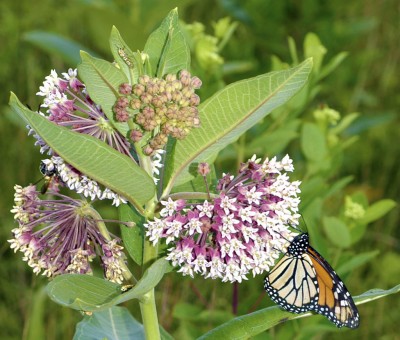November 1, 2018

Source: Iowa State University
While the monarch butterfly is a globally distributed species, the eastern United States population is renowned for its annual migration from the breeding range in the northeastern United States (and Canada) to overwintering sites in central Mexico. Overwintering populations of this cohort have declined by approximately 80% over the past twenty years. Several factors are believed to contribute to the decline, including logging at the overwintering sites, climate change, and changes in land use and agricultural practices in the summer breeding range. In 2014 the United States Fish and Wildlife Service was petitioned to list the monarch as an endangered species, and a decision is expected in mid-2019. Iowa is in the center of the region where the greatest number of migrating adults are produced. Classification of the monarch as endangered could have significant ramifications to Iowa agriculture since the Endangered Species Act provides for conservation of both the endangered organism and its habitat.
The Iowa Monarch Conservation Consortium was formed in 2015 to establish a scientific foundation for monarch conservation efforts. The consortium is a partnership of farmer and conservation organizations, state agencies, industry and Iowa State University. The Agronomy Department has supported research investigating the impacts of crop production on monarch reproduction, and methods to enhance the landscape to support monarchs.
The elimination of common milkweed from crop fields in the Cornbelt is frequently cited as the primary cause of the monarch decline by many monarch researchers. Surveys of Iowa crop fields found nearly a 90% reduction in the number of corn and soybean fields infested with common milkweed between 1999 and 2009 (Hartzler, 2010). Although the cause of this decline in common milkweed can’t be determined with the methods used, the widespread use of glyphosate following the introduction of glyphosate resistant crops likely played a major role in the loss of cropland milkweed.
Conservation plans for protecting the monarch call for doubling the quantity of milkweed in the monarch’s breeding range. This strategy assumes that milkweed in crop fields was an important resource for monarchs; however, there is little data to support this assumption. Common milkweed is a perennial able to survive many of the herbicides used in crop production, but these herbicides cause significant injury to the foliage. We suspected herbicide injury would reduce the suitability of common milkweed for monarch reproduction. Experiments were designed to determine if damage associated with postemergence herbicides affected ovipositing preference or larval survival rates. We found that fomesafen, a commonly used postemergence in soybean, caused severe necrosis and loss of common milkweed leaves contacted by the spray. However, injured plants resumed normal growth shortly after application, and monarch utilization of treated milkweed was similar to plants not exposed to fomesafen (Table 1). Our research supports that milkweed in crop fields can be a resource for monarchs, but it is unlikely that common milkweed will return to earlier densities in crop fields under current crop production practices.
Table 1. Effect of postemergence fomesafen applications on utilization of
common milkweed in soybean fields. Lizotte-Hall and Hartzler, 2018.

Patches of 5 plants per 3 sq ft were established in soybean.
No differences between treatments in egg or instar numbers.
Significant efforts are being made by both government and private organizations to diversify the landscape in the reproduction range to increase available resources for monarchs. The expense of converting areas not eligible for government programs (e.g. CRP, CREP, etc.) to diverse plantings of native plants may be cost-prohibitive for many farmers/landowners. We evaluated a low-cost alternative to enhancing the diversity of non-cropped areas present on most Iowa farms. Smooth sod brome was suppressed with low rates of glyphosate and then the areas were seeded with common milkweed and other forbs. While suppressing brome with glyphosate increased recruitment of forbs, competition from the perennial sod resulted in very low establishment of the native plants. New England aster and golden alexander were more successful at establishing than common milkweed. Additional work should investigate additional techniques to suppress sod without increasing the likelihood of invasion of areas by weeds.
The decline of the monarch population is complex issue. Iowa’s agricultural community will need to participate in restoration efforts for the monarch due to the importance of Iowa to monarch reproduction, and because the majority of Iowa’s land is involved in crop production. It is unrealistic to expect farmers to adjust management practices to allow increased survival of common milkweed in crop fields. Thus, research is needed to determine how to best modify areas outside of crop fields to support monarch reproduction and survival.
This article was originally prepared for a presentation to the Department of Agronomy’s Baker Council. The research reported was part of Sidney Lizotte-Hall's M.S. research.
Hartzler, R.G., 2010. Reduction in common milkweed (Asclepias syriaca) occurrence in Iowa cropland from 1999 to 2009. Crop Prot. 29, 1542-1544.
Lizotte-Hall, S.E. and R.G. Hartzler. 2018.Effect of postemergence fomesafen application on common milkweed (Asclepias syriaca) growth and utilization by monarchs (Danaus plexippus). Crop Prot. 116:121-125.
Originally posted by Iowa State University.
You May Also Like




